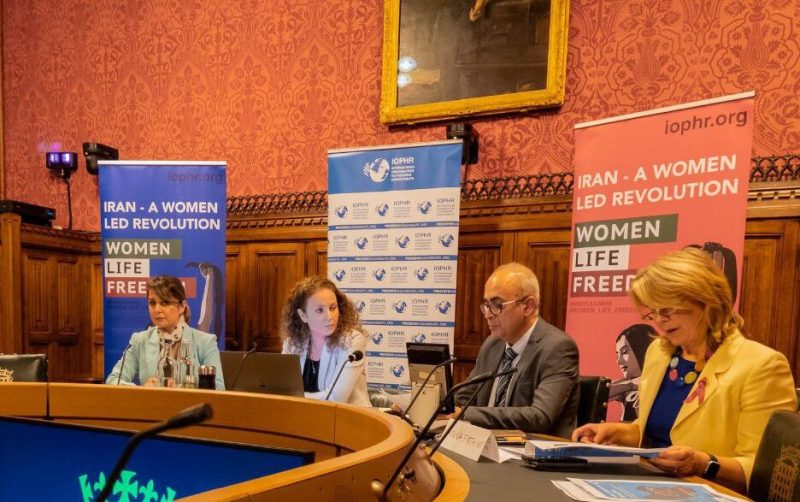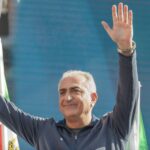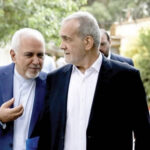Interview with Afshin Sajedi, Legal Advisor at the International Organisation to Preserve Human Rights (IOPHR) about the cicrumstances of the presidents death, the genral situation in Iran, Mojtaba Khameneis role, and the leaders possible strategic moves.
mehriran.de: What groups are you affiliated to?
I was born in Tehran and moved to Belgium with my family in 2001. I had graduated prior in Iran in the field of Diplomatic and Political Relations and graduated with a second degree in Belgium on European Politics and Policies. I am the European Representative and Legal Advisor at the International Organisation to Preserve Human Rights (IOPHR).
The International Organisation to Preserve Human Rights (IOPHR) is a non-profit human rights organization. It is an independent initiative of European and Iranian human rights activists. There is no financial support by any state-run, half-state-run or non-state-run institution. IOPHR does not follow any political party. The commitment of IOPHR members is voluntary.
The members joined together to create this group of volunteers out of universality and consciousness of human rights as stated by the UN Universal Declaration of Human Rights and in solidarity with the people of Iran. IOPHR stands solely for peaceful means to object and protest human- and civil rights violations in Iran. In addition, IOPHR continues to carry out education-based initiatives across Europe, including multiple events held at the European Parliament regarding the increasing threats posed by violent extremism being committed under the name of Islam, in order to preserve and protect the democratic values of the West.
mehriran.de: To which values do you feel connected?
As part of IOPHR’s focus on Religious Freedom, I have worked to highlight the widespread oppression of the Gonabadi Sufis in Iran, in addition to all other religious minorities.
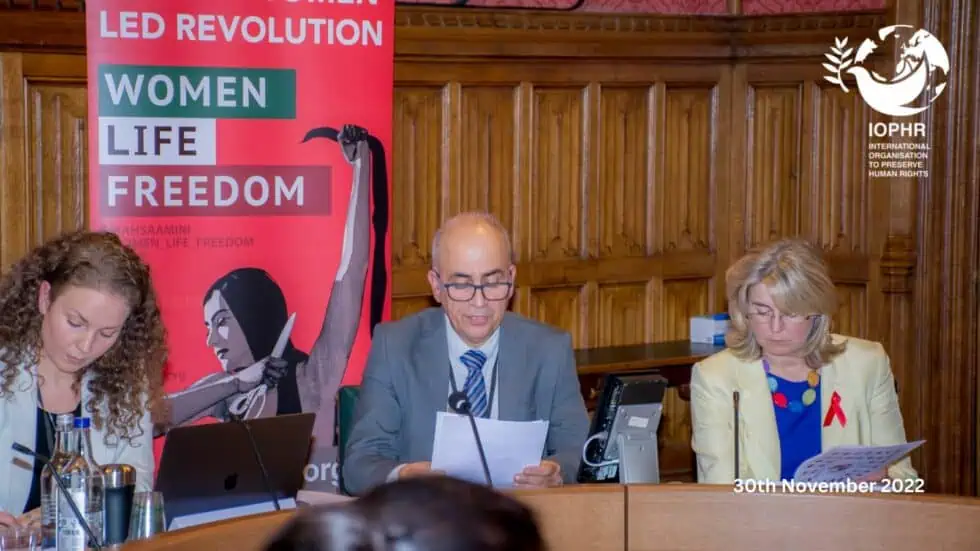
mehriran.de: Your general description of the current situation in Iran.
To provide an accurate answer first we have to have a deep understanding of the ruling regime structure. The regime known as Islamic Republic of Iran has a dual governance structure consisting of an upper level, which is the Religious Core, and a lower level, which is the External Face.
The religious core, which consists of about fifty unelected bodies, including the Supreme Leader and affiliated organizations, controls all power in Iran. The lower level consists of three (so called) electoral bodies, but they are completely under control of the Guardian Council which in own turn is just one of the more than 50 bodies under supervision of the Religious Core.
Since that the Supreme Leader is the head of Religious Core, thus the lower level of governance is also under the indirect control of the Supreme Leader, with no executive power. It means that the elected bodies do exist only to present a representation of a national government, and the lower level is considered an External Face of the Religious Core.
The Religious Core uses the lower level as a mask to hide its extremism. Iran has not fully implemented the requirements of the Financial Action Task Force, making it unable to join as a full member due to the lack of control over the institutions under the supervision of the leadership.
Understanding the dichotomy between the Religious Core of the state structure and its External Face is crucial. Many institutions under the control of the Religious Core operate freely abroad while being financially dependent on the state. These entities present themselves as non-governmental organizations (NGOs) abroad and enjoy the privileges and exemptions associated with such status. Moreover, they often evade sanctions by asserting their independence from the government.
It is important to acknowledge that while they may not directly rely on the government, they are instead dependent on the upper level of the state structure that oversees both the government as lower level and these institutions. This deception enables them to mislead governments and international organizations.
In such a dual structure, the supreme leader functions as the caliph, and the president acts as his steward. It is expected that the president serves the caliph fully. However, in practice, the responsibilities of the presidency in today’s world have their own demands. Consequently, the president often seeks more authority, regardless of his loyalty to the supreme leader.
Based on this, over the past forty-five years, all the nine heads of state have encountered unusual fates:
Bani-Sadr, the first president, escaped the country to avoid execution.
Rajai was assassinated.
Mousavi has been under house arrest for over 15 years.
Rafsanjani drowned (likely assassinated) in a pool.
Khatami is under control and banned from public activities.
Ahmadinejad, once considered one of the most loyal presidents to the Supreme Leader, had a falling out over the appointment of the Minister of Intelligence and Security during his presidency. Despite his loyalty, he dismissed the minister trusted by the Supreme Leader for fifteen days, creating a security margin for himself by possessing important documents related to the Supreme Leader’s family. He is now seen as an opponent of the government.
Rouhani is awaiting a possible trial, and Raisi as the president is probably assassinated.
mehriran.de: Who were the people attending the funeral of Raisi?
Using new artificial inteligence techniques, critics have estimated from published official photos that up to ten thousand people participated in the funeral. Given that the leaders of Hamas and Hezbollah gave speeches in Arabic during the ceremony, and these speeches were not translated in real time, it can be assumed that most of the participants were brought to the funeral from Arab countries such as Iraq, Lebanon and Palestine at the expense of the government.
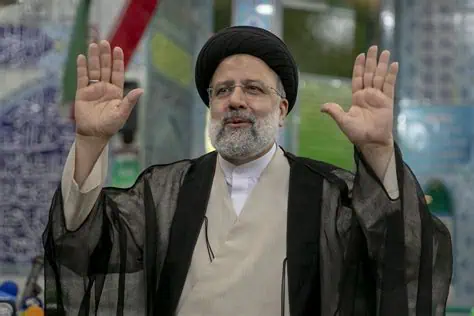
mehriran.de: Did Raisi really die in an accident?
Despite the official efforts to make the crash of the president’s helicopter and his entourage look like an accident, there is strong and undeniable evidence that strengthens the possibility of the assassination of the president.
The motorcyclists who reached the remains of the helicopter carrying Raisi and his companions before anyone else, say, they took videos of the crash site and the bodies. However, the authorities do not allow the release of the videos for security reasons.
According to them, the helicopter carrying the president and his companions had completely exploded“, „everything was burnt“ and the filmed documents are also available.
One of the volunteer rescuers says they had to submit the initial video of the helicopter remains and its passengers to „security forces,“ and another says that „for security reasons, it is not possible to broadcast it.“
The intelligence agencies‘ prevention of publishing the first images prepared by Iranian volunteer rescuers contrasts with the Turkish media, which have published a video report of the helicopter wreckage by that country’s journalists.
However, in an official photo that was allowed to be published, the bodies are shown to be completely burned, while there are no signs of burning or fire on the trees and grass on the ground. This strongly supports the hypothesis that the helicopter was blown up in the sky, either by external gunfire or by the detonation of a pre-deployed, remotely controlled bomb.
Facts: The president’s convoy typically consists of three helicopters: the lead helicopter, the carrier helicopter, and the escort helicopter. According to reports, for unknown reasons, the president, the foreign minister, the governor, and the leader’s representative in the province switched helicopters and all boarded the lead helicopter together.
It was also reported that the escort helicopter saw smoke coming from the crashed helicopter and reported this. Therefore, they had an idea of where the helicopter might have gone down, making the length of the rescue operation seem a little unusual.
However the Raisi’s helicopter transported him without any problems at the beginning of the day thus it seems that the helicopter had no technical problem.
Conclusion: The weather conditions were not uncontrollable. – The weather conditions were the same for all three helicopters. – Two helicopters reached their destination safely.
If two helicopters had crashed and one had been rescued, the cause of the crashes could be considered weather-related. However, since two helicopters reached their destinations safely and only the helicopter carrying the president and senior officials had an accident, it cannot be considered a result of bad weather conditions.
Another point is that if the helicopter carrying the president and senior officials had crashed into the mountain due to bad weather conditions, as claimed in the official statements, the entire wreckage of the helicopter should be present. However, in the published photos, only half of it is visible. The complete absence of the helicopter’s body suggests a possible explosion in the sky.
Additionally, the bodies suffered severe burns, indicating a significant fire caused by the combustion of helicopter fuel. Yet, there is no sign of fire in the trees and forest where the helicopter’s wreckage was found. This supports the possibility that the helicopter caught fire in the air due to an explosion or was shot, and then crashed after burning.
Based on the evidence and the resulting findings, it appears that the helicopter carrying the president and his accompanying delegation was either blown up or targeted.
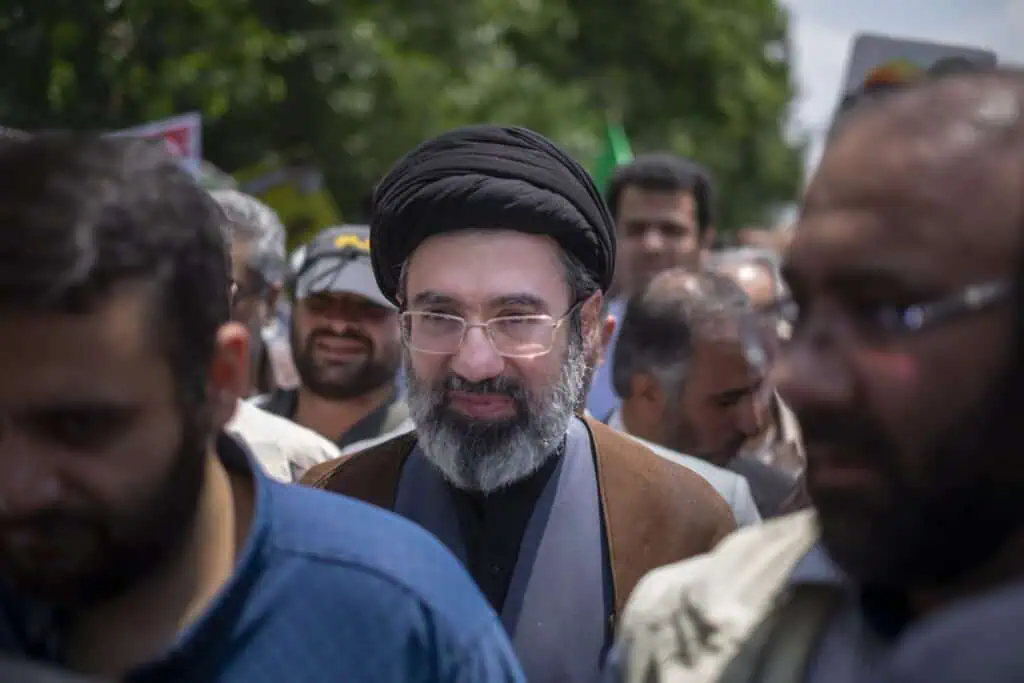
mehriran.de: How was Mojtaba Khamenei involved?
In any crime, it is crucial to examine both the material factor (the instrument of the crime) and the immaterial factor (the motive). Thus, in any incident, those who stand to benefit are the primary suspects, as their gain represents the motive or immaterial factor of the crime. To identify the perpetrator, suspects should be classified based on the extent of their benefit or their motivation.
In this case, we have four main suspects: Israeli intelligence agencies, Russian intelligence agencies, Mojtaba and his gang, and possibly Western intelligence agencies, especially the CIA.
The reason why Israel’s intelligence agency is at the top of this list is the general belief that Israel intended to retaliate the recent regime’s military operations against Israel. However, upon closer examination, this belief seems unlikely for several reasons:
1. Israel has a long-standing policy of not attacking leaders and government officials, even during wartime, and there is no historical record of Israel engaging in such actions. Mossad’s cross-border operations strictly adhere to the protocol of respecting political immunity.
2. If Israeli intelligence agencies were to conduct an operation in Iran, their primary targets would likely be the leaders of terrorist military proxy groups responsible for the deaths of Israeli citizens. This aligns with Israel’s commitment to its people. We know that leaders of some militia groups such as Hamas and Hezbollah are currently in Iran and are not as heavily protected as the president, making them more likely targets. Therefore, Israeli intelligence agencies should not be at the top of the list of suspects.
Russia emerges as another potential suspect. According to reliable sources, including former KGB agent Yuri Bezmenov, the agency has a history of eliminating its own agents for various reasons.
Yuri Bezmenov, also known by the alias Tomas David Schuman, was a Soviet journalist and KGB informant who defected to Canada in 1970. He is best known for his outspoken criticism of the Soviet Union and his detailed explanations of the KGB’s methods for undermining Western societies through ideological subversion.
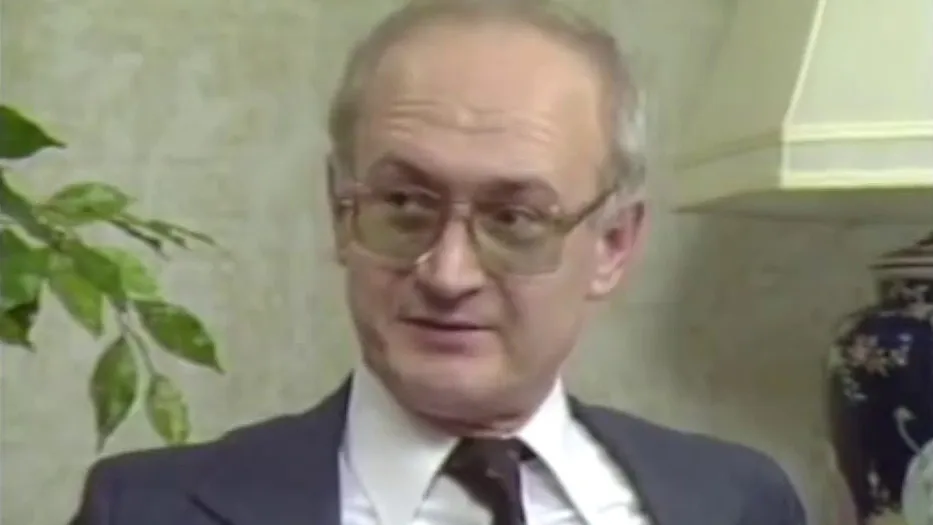
Bezmenov gave numerous interviews and lectures in which he explained Soviet strategies for subverting Western societies. His most notable interviews include those with G. Edward Griffin, in which he laid out the subversion process in detail.
In his interviews, Yuri Bezmenov explains that the KGB targeted leftists collaborating with the Soviet Union and eliminated those deemed threats after revolutions. He clarifies that these purges were implemented globally as a policy by the Kremlin.
There is no doubt that Raisi was a servant of Russian policies, he had repeatedly introduced himself as a servant of Russia during his trip to Russia. Even once in a meeting with Putin, he told him that : “I am at your service”. Of course, his friends attributed this to his ignorance of diplomatic etiquette, but his critics used his statements as a strong proof that he is a faithful executor of the Kremlin’s orders. Even Russian Foreign Minister Sergei Lavrov said in his tribute that he was a true „patriot“!.
As mentioned, the removal of the servants coincided with a shift in the Kremlin’s macro-regional policies. However, it’s unclear if the Russian macro-regional policy towards Iran has been changed and whether this change in policy directly motivated the removal. Additionally, Raisi’s position could still be beneficial to Russia’s future goals, regardless of these policy changes. Therefore, Russia’s involvement in Raisi’s removal seems unlikely.
On the contrary, it seems that the Kremlin was worried about him.
The unexpected summoning of the Iranian ambassador in Moscow to the Kremlin Palace at 10:00 p.m. at the same time as the report of the helicopter accident indicated the concern of the highest officials of the Kremlin about the state of the president.
The fact that it is said that Russia summoned the Iranian ambassador at 22:00 to express sympathy and send the necessary aid is unnecessary. In such cases, the ambassador is usually summoned to the Ministry of Foreign Affairs and the meeting is at the level of the head of the relevant department or at most the deputy of the Ministry of Foreign Affairs.
Summoning the ambassador and meeting with Putin in the Kremlin palace undoubtedly shows Putin’s concern for the fate of the helicopter accident.
It is even said that Putin reprimanded the ambassador in this meeting and informed him of the Russian government’s displeasure with what happened to the president.
After that, a video of sending part of the Russian forces stationed in Armenia to Tabriz was published in the media close to the government.
This does not mean that the regime was worried about Raisi’s interaction with Russia. To better understand this issue, we should know that based on the seventh clause of the treaty that was signed two hundred years ago between Iran and Russia, during which Iran handed over thirty percent of its lands to Russia, the Qajar dynasty that ruled Iran at that time became a protectorate of Russia. The Shiite clergy also came under the protection of Russia due to its strong entanglement with the loyal court, and since then, the Shiite clergy in Iran and even in other countries such as Lebanon have been following completely Russophile policies.
Based on this, it can be assumed that Raisi is a victim of the competition of different clerical factions close to Russia. There is no doubt that the ruling regime in Iran is a completely Russophile regime. During the forty-five-year history of this regime, there are many evidences of the Russophilism of this regime, the latest of which is the full support of the Iranian regime to Russia in the war against Ukraine. Failure to comply with western sanctions against Russia and sending weapons to Russia is not denial or waiver.
It is in this section that Mojtaba’s role becomes prominent. It may be interesting to know that the day after the incident, Raisi was supposed to inaugurate the Assembly of Experts, which has the authority to appoint the next leader.
If a president participated in this meeting, he would undoubtedly be elected as the chairman of the Assembly of Experts, and this would mean a high hand for him and his faction to lead the country in the future.
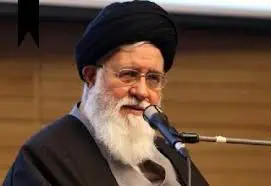
His father-in-law, Ahmad Alam Al-Hoda, is the head of Iran’s richest religious center, Awqaf and Astan Quds Razavi, and according to many, he is the second or third person in the pyramid of power in Iran.
For him, Ebrahim Raisi’s presidency meant a preparatory stage to reach the leadership position. An option that caused great concern to Mojtaba and his father Ali Khamenei.
This hypothesis is further strengthened by the fact that reliable reports have been published about the attack of the security forces on the house of Alam Al-Hoda in Mashhad. This is a sign that after the confirmation of his death the gang affiliated with him has been under pressure from the security forces.
As another sign, the latest speech of Raisi’s deputy during his commemoration ceremony, indicates seriously also the dispute which was between Ebrahim Raisi & Mojtaba Khameni about the issue of successorship: “Unfortunately, we have had presidents who considered themselves leaders, while our constitution has defined the limits of the legislature, executive, judiciary and authority”.
Another sign is the speech of one of the famous eulogists of the government, who warned the future president to know his place well and never think of becoming a leader.
All these show that Mojtaba had sufficient motivation and could have been responsible for Raisi’s assassination, but there is no indication that he was alone in this murder and that other currents and factions were not involved in this assassination.
Reformists are also another suspect of this assassination. They have been removed from all government positions for years and have repeatedly announced that the policies of the leadership and the head of government have brought the country to the brink of destruction. With such thinking, the possibility of their participation in this murder even with the motive of saving the country from the danger of destruction is probable.
Negotiations between Biden administration and Iranian regime in Oman
Recently, it has become clear that behind-the-scenes negotiations between the Iranian government and the Biden government are underway in Oman. Undoubtedly, one of the main goals of the Biden government from behind-the-scenes negotiations with the Iranian regime – and not necessarily the Iranian government – is to force the Iranian government to adopt a policy of distancing itself from Russia.
Coincidentally, this policy is supported by the reformist faction on one side and Mojtaba Khamenei’s gang on the other side. Therefore, the involvement of Western security services, especially the CIA and the Intelligence Service, in this assassination with assistance of reformists cannot be ruled out.
By accepting this hypothesis, the main reason for the adoption of strange and unexpected policies of Western governments, which are formed around appeasement with the Iranian regime, becomes clear.
There are evidence of the influence of the reformists of the Iranian regime in the administrative organization and the policy-making process of the Democratic Party, and it is very likely that the powerful lobby of the Iranian regime (affiliated with reformists) in America has convinced the Biden statesmen that the best option for the interests of the West is the presence of a reformist government like during the presidency of Mohammad Khatami or Hassan Rouhani.
Axis of appeasement
By accepting this hypothesis, the main reason for adopting strange and unexpected policies of Western governments, which are formed around the axis of appeasement with the Iranian regime, becomes clear.
Therefore, the probability of involvement or at least knowledge of the western intelligence agencies in this assassination is very high, especially since a while ago, when a terrorist act occurred in the city of Kerman, the United States government officially announced that it had informed the Iranian government about this terrorist attack through official channels.
Therefore, the belief that the assassination of the president of Iran took place without the knowledge of the western intelligence and security organizations does not seem acceptable and is naive.
Another point that must be mentioned is that at the last moment before the helicopters took off, one of the president’s companions named „Bazarpash“, who was the Minister of Roads and Transport of his government, refused to board the helicopter, boarded another one and thus was saved from certain death.
He, who is also an official member of the IRGC, has immediately after the presidents death, launched his election campaign for the presidential election, which will be held in one months time!
It is as if he was prepared in advance and had prepared the necessary supplies. Therefore, probably the IRGC was engaged in the implementation of the plan of assassination. It should be noted that the helicopter crash is usually one of the cases related to the Ministry of Roads and Transport of Iran.
Eliminations through air accidents
It is pointed out that the elimination of political officials through air accidents during the era of Islamic rule is very common and has a history. First of all, it should be stated that the Islamic Republic of Iran holds a record among the countries of the world by recording one hundred and twenty eight domestic air accidents recorded during forty five years! For comparison, it is enough to note that during the fifty years of the kingdom’s regime, only two cases of air accidents were recorded! In particular, it should be mentioned that since the IRGC dominated government affairs in the first year of Ahmadinejad’s presidency over the executive branch, the number of air accidents suddenly jumped tenfold to an amazing figure of eleven per year. Just a few examples are as follow:
Sep. 29, 1981
A thirty-two army plane carrying army and corps commanders crashed in Kahrizak, 80 passengers including Brigadier Valiullah Fallahi, Chief of Joint Staff, Mohammad Ali Jahanara, Commander of Khorramshahr Corps, Yusuf Kolahdoz, Deputy Corps Commander, Defense Minister Colonel Sayyed Musi Namjo, and Air force commander Pilot Colonel Javad Fakhuri was killed. It is said that these commanders were going to Tehran to present a peace plan and end the war with Iraq, but were removed by elements in the political leadership of the time.
February 20, 1986
A Dutch Friendship plane crashes in the north of Ahvaz due to a rocket fire and all its passengers are killed. This plane was carrying Fazullah Mahalati, Khomeini’s representative in the IRGC, along with a group of parliament members and high-ranking judges. In the official statements, the missile fired by the Iraqi MiGs was introduced as the cause of the plane crash and even the tape that was claimed to have been taken from the Flight recorder of the plane was fake and hand-made.
February 18, 2016
The flight number 3704 of Asman airlines that was heading to Yasouj from Tehran crashed near destination. The plane was carrying environmental officials and activists, who had a very sensitive meeting with parliamentarians on the same day about the environmental effects of the IRGC’s nuclear activities, and all of them were killed in this accident. The point to be noted about this incident is the delay and time spent by the relief organizations to rescue the injured as according to reports, some of the injured were still alive after the plane crash and used their cell phones to ask help, but due to delay of the rescue workers, all passengers passed away.
This is the same point that can also be seen in the case of Raisi’s helicopter crash. The government’s delay in finding the helicopter is inexplicable. We know that in the end, the wreckage of the helicopter was not found by Iranian drones, but it was Turkish drones that entered Iran’s airspace and easily identified and found the wreckage of the fallen helicopter. It is not known how long the Iranian authorities would have wanted to prolong the search process if the Turkish drones had not found the wreckage of the helicopter.
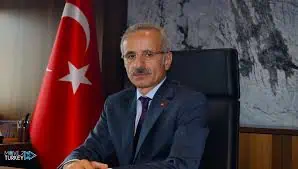
In this regard, Turkish Transport Minister Abdulkadir Oraloglu told reporters that after hearing the news of the crash of the helicopter carrying Ebrahim Raisi, the signals were checked, but no signal was received. The Guardian reported, quoting Oraloglu: Investigations show that this helicopter did not have a transponder or that it was most likely turned off.
I would like to mention here, inspired by the famous novel „Murder on Orient Express“, that all the suspects of this assassination may have played a role in the execution of this assassination.
It is impossible to imagine that the American, British, Israeli and Iranian intelligence agencies could not have predicted this assassination. Therefore, perhaps the removal of a president has happened in an exceptional way and was agreed upon by all interested groups.
mehriran.de: What about the role of the technical crew member who was a cousin of parents of a man who was executed by the regime?
Yes, it’s true. Some members of Pooya Bakhtiari’s family have announced without any comment that the pilot of the helicopter that crashed was a close family member. The publication of this point raises the possibility that the pilot may have deliberately crashed the helicopter into the mountain as an act of revenge for the oppression experienced by Pooya Bakhtiari’s family. Official government reports claim that the helicopter crashed after hitting a mountain. This suspicion is strengthened by the fact that the pilot of the downed helicopter was a military member of the army and not the IRGC. This adds to the complexity of the matter because high-ranking government officials do not have much trust in army cadres, and it is unclear why an army cadre was used for the presidential transfer instead of an IRGC member.

On the other hand, no letter or testament from the downed helicopter pilot has been found, or at least none has been published, in which he explains his motivations—possibly vindictive. It is very unlikely that a pilot would commit a suicide operation for revenge without leaving a letter or a will that clearly explains the reasons and motives for his action. It is important to mention that two members of the Bakhtiari family, who had previously revealed their family relationship with the pilot, were forced to remove their posts from social media due to pressure from the security forces.
However, until more evidence is revealed, this remains a valid consideration as one of the possible reasons for the crash of the presidential helicopter.
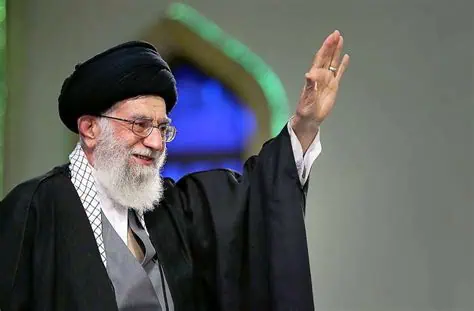
mehriran.de: What could be Ali Khameneis next strategic step in this situation?
For an accurate answer to this question, various factors must be considered:
First, is the dual structure of power in Iran. As mentioned, the Islamic Republic of Iran has a dual governance structure consisting of an upper level, which is the Religious Core, and a lower level, which is the External Face. The Religious Core, consists of more than 50 unelected bodies, including the Supreme Leader and affiliated organizations, controls all power in Iran. The Lower Level consists of just 3 -so called- electoral bodies: presidency, parliament and expert council. All three are completely under full control of just one the 50 bodies of Religious Core named Guardian Council. This council is under the direct control of the Supreme Leader.
Therefore, although it may appear that the Islamic Republic of Iran operates under a two-tiered structure, combining a caliphate and a republic, the reality is quite different. In actuality, the republic’s structure is largely ceremonial, and the country’s constitution concentrates all power in the hands of the „caliph,“ who is neither accountable to domestic nor international laws. Under the caliphate system, Iranian citizens are considered „subjects“ and are required to obey the caliph’s orders.
Subjects of the Supreme Leader – caliphate system
Thus, the political system in Iran is not just a nation-state, it can be described as a „bi-structural Caliphate system“ where the position of the supreme leader takes precedence over the concept of „citizen“. In this system, individuals are not viewed as citizens but rather as „subjects“ of the supreme leader.
Acknowledging this issue could justify Khamenei’s indifference to the growing opposition within the country. He once said that his true followers are abroad. He neither believes in national system nor in political boundaries and seeks to establish a caliphate system among the Muslims across the world. Based on this, he not only does not need citizens, but the citizenship system can even be troublesome for him to some extent.
The citizenship system is based on the mutual relationship between the state and the citizen, wherein both have mutual rights and duties towards each other. In such a relationship, the legitimacy of the state of government depends on the will of the citizens. This means that even in a dictatorship, the government is (or at least should be) accountable before the citizens.
In contrast, in a caliphate system, it is claimed that the caliph is determined by divine authority, and people on earth, who are considered God’s servants, are also seen as the caliph’s servants, obligated to obey the caliph whether they want to or not. In such a system, political boundaries and nationalities have no meaning.
According to this, Iran is not his primary focus, but rather one of the provinces or states of his emerging caliphate. However, because Iran is temporarily considered the center of his caliphate, a minimum level of stability is required there.
Thus, he is trying to use his loyal followers from different nationalities around the world, whom he has already convinced through religious methods to be loyal to him, to create instability in their countries of residence. In this way, he can export „instability“ and use it as a tactic to blackmail and impose his views, eventually securing a minimum level of stability in the country where he resides. This is his first vital priority.
The nuclear project
He has said many times that they are climbing to the „peak“ and are very close to it. He likely means the „point of no return“ in the nuclear project. His belief is based on the calculation that if he can successfully conduct his first nuclear test, his survival will be guaranteed forever, and he will no longer have to worry about the future of himself and his regime.
Therefore, the progress rate of the nuclear project is the second factor that should be considered in answering this question.
Succession – Mojtaba Khamenei
The third point that should be considered is the issue of succession. As previously explained, in the caliphate system, at least fifty organizations are under his control. His own office is one of his most powerful institutions, with at least two hundred billion dollars in wealth and unlimited influence. This institution is managed by his son Mojtaba. He has skillfully avoided appearing in public media and on social networks for all these years, so there is no clear image of him in the eyes of the public. This lack of visibility is not important because public opinion is not intended to be involved in this matter.
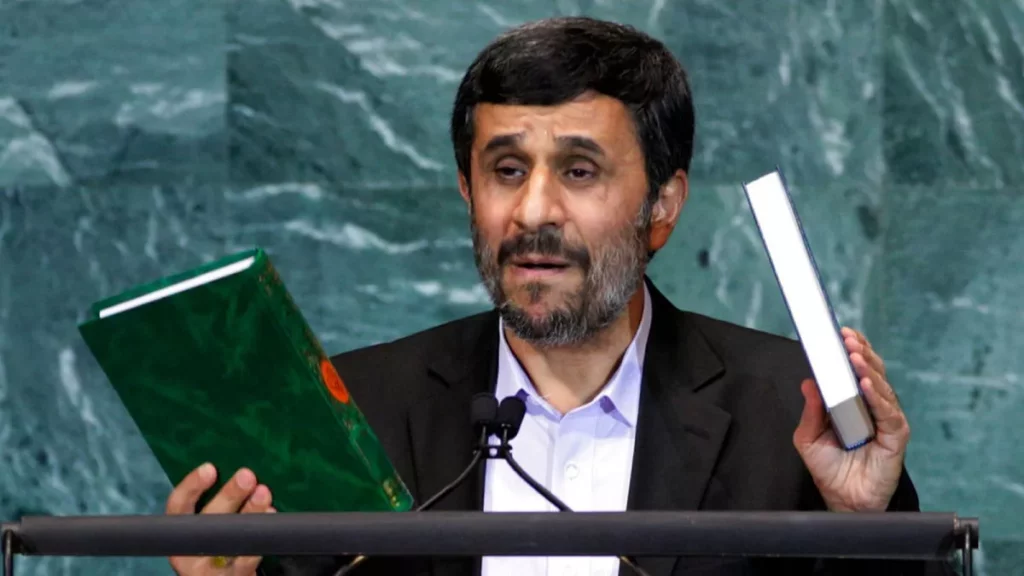
For the first time, during the public protests against electoral fraud in the presidential elections of 2007, Mojtaba’s role in vote manipulation for Mahmood Ahmadi Nejad was raised by prominent presidential candidates of that time. Since then, there have been numerous reports of his overt and covert interference in the removal and installation of government officials, the engineering of parliamentary elections, and even the appointment of ministers.
It is said that all officials in the Ministry of Oil, the most lucrative ministry, are appointed by him. Additionally, he is a well-known figure among proxy groups abroad.
Therefore, at this time, the biggest challenge to Khamenei is to compel the Assembly of Experts to appoint his son as the future leader. This task does not seem easy due to the presence of other powerful and experienced contenders. However, he hopes that the physical elimination of Raisi, the most serious and important option, has sent a clear message to the others.
Interview in May 2024, @Helmut N. Gabel, mehriran.de

